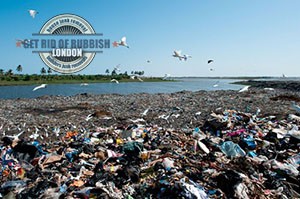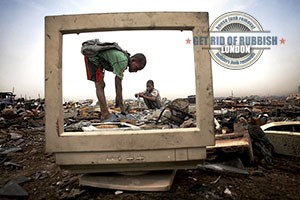The developing world has been known to struggle (to say the least) when it comes to effective rubbish removal and waste management. In recent decades, despite the many programs, initiatives, charters and agreements between countries and international organisations alike, the gap between developed and developing countries in terms of proper waste management has been growing ever wider. In reality, in the last twenty to thirty years developed countries have grown cleaner while developing ones have grown dirtier. Separating the world into two categories – developed and developing might be convenient and sensible from an economic point of view, but when it comes to environmental protection and natural resource pollution, dividing the world makes little if any sense as the damage caused and sustained will eventually be shared amongst all nations across the world.
 There is also another alarming trend becoming more and more apparent – the ever growing number and size of open tips. Open tips or open dumps are vast spaces of land which have been turned into tips where all sorts of hazardous and nonhazardous waste are dumped indiscriminately without any regard for health and welfare of both humans and nature alike. Unfortunately, the growing open tip trend is yet again prominent in developing countries of Africa and Asia. It doesn’t take the mind of a rocket scientist or brain surgeon to put two and two together to realise that this can’t go on forever and that not long from now, these toxic and infested giant heaps of waste will become a major (hopefully reversible) problem to put it mildly. At the moment there is evidence of about fifty giant open dumps in different countries around the world. Evidence was collected through satellite imagery and other official means which makes denial are really losing strategy for those who turn a blind eye to these open dumps – most of the time politicians (of different ranks) in developing countries.
There is also another alarming trend becoming more and more apparent – the ever growing number and size of open tips. Open tips or open dumps are vast spaces of land which have been turned into tips where all sorts of hazardous and nonhazardous waste are dumped indiscriminately without any regard for health and welfare of both humans and nature alike. Unfortunately, the growing open tip trend is yet again prominent in developing countries of Africa and Asia. It doesn’t take the mind of a rocket scientist or brain surgeon to put two and two together to realise that this can’t go on forever and that not long from now, these toxic and infested giant heaps of waste will become a major (hopefully reversible) problem to put it mildly. At the moment there is evidence of about fifty giant open dumps in different countries around the world. Evidence was collected through satellite imagery and other official means which makes denial are really losing strategy for those who turn a blind eye to these open dumps – most of the time politicians (of different ranks) in developing countries.
One of the biggest and most toxically dangerous open dumps is Mbeubeuss in Senegal. The original dumpsite, twelve miles north of Dakar, capital of Senegal (Africa) was started forty five years ago, as a regular open tip to serve the local community. Nearly half a century on, from the sky and from the ground, Mbeubeuss has turned into a giant ecological time bomb slowly ticking away, waiting to go off. The tip is alarmingly close to the Atlantic coast of Senegal, during the years it has grown and occupied nearly two hundred hectares of a dried up lake bed. To make matters worse, satellite and areal imagery shows the site is traversed by paths, roads and walkways, people are grazing goats and sheep on the disease infested hillsides of the tip, while others seem to be going about their daily routine right there at the tip.
In a nutshell, Mbeubeuss reflects the growing consumerism in (countries like) Senegal, and the inadequacy of national legislation (if there is such at all) on how to go about rubbish removal and waste management. To make matters worse, as if a city of three million people (Dakar) where waste effective waste management is still a foreign word is not enough, Senegal has been a part of the waste trade for a period of time now, meaning that there is more waste being transported and delivered to Senegal. One such country which is still finding its economic footing in the world, the prospect of being paid to keep someone else’s rubbish might have seemed lucrative, but nowadays it’s become a lose-lose situation for everyone, even if it doesn’t seem so right now. At the start Mbeubeuss was just a local tip where farming and organic waste was deposited for natural degradation under forces of nature. In the last decades however, the tip has become a dumpsite for all sorts of toxic waste, coming from anything from electronics and batteries to medical waste and what not. In the early days, there were only about few thousand tonnes of waste coming in per year, now there are almost half a million (known) tonnes of waste dumped there annually.
Mbeubeuss is just one of over fifty well-known and documented open dumps across the world. Each of these open dumps, no matter where they are, is growing in both size and toxicity. The most reliable source for information on these ecological time bombs is the New Atlas of The World’s Biggest Dumps. In recent years, Mbeubeuss seems to be the leader in terms of size and infestation, making it perhaps the largest and most dangerous such site in the world. Another infamous open dump on the African continent is Agbogbloshie in Accra, Ghana. The site eats up the staggering two hundred thousand tonnes of mostly electronic waste, per year. One of the biggest sources of infectious disease and contamination of natural resources (if there are any left) is the Awotan open tip in Ibadan, Nigeria. Another worthy contender, of course of all the wrong reasons, is Dandora just outside Nairobi – the Kenyan capital. Dandora sees nearly seven hundred and fifty thousand tonnes of medical, industrial, farm and household waste on an annual basis.
 The list of horrid, infested open dumps goes on and on. Until governments of developed and developing countries don’t come together on the issue, there will be no notable changes, especially in third world nations – on the receiving end of much of the pollution. Having said this, it is the global industry that’s also to blame, but after all they produce for the consumer society and their endless, outrageous needs and wants. Rubbish removal in urban areas is just the tip of the iceberg, clean streets and parks don’t necessarily mean waste is being managed effectively. Although waste management practices are improving and growing ever more efficient, there is still a lot to be desired, in all countries of the world – rich or poor. Re-education and public awareness must also be made a priority because a clean, healthy environment comes through clean and healthy living patterns and habits.
The list of horrid, infested open dumps goes on and on. Until governments of developed and developing countries don’t come together on the issue, there will be no notable changes, especially in third world nations – on the receiving end of much of the pollution. Having said this, it is the global industry that’s also to blame, but after all they produce for the consumer society and their endless, outrageous needs and wants. Rubbish removal in urban areas is just the tip of the iceberg, clean streets and parks don’t necessarily mean waste is being managed effectively. Although waste management practices are improving and growing ever more efficient, there is still a lot to be desired, in all countries of the world – rich or poor. Re-education and public awareness must also be made a priority because a clean, healthy environment comes through clean and healthy living patterns and habits.
|
The Tell-Tale Signs of an Open Dump – Is There One Near You? |
Widely dispersed uncovered waste |
|
Open fires and/or waste periodically on fire |
|
|
No recording or inspection of incoming waste |
|
|
No control of waste placement |
|
|
No compaction of waste |
|
|
No application of cover soil, or minimal cover (often associated only with forming access roads) |
|
|
Scavenging at site |
|
|
No security |
|
|
Vermin, dogs, birds and other vectors often present |
|
|
poor or no leachate management |
|
|
No provision for the management of landfill gas. |
